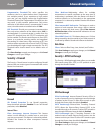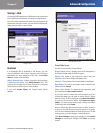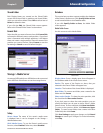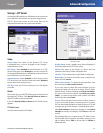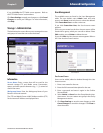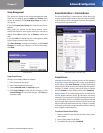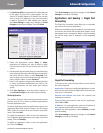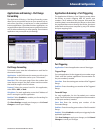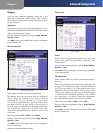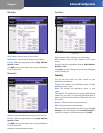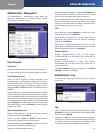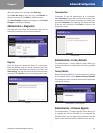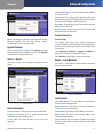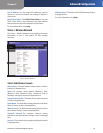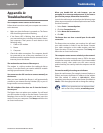
Chapter 3
Advanced Configuration
26
Simultaneous Dual-N Band Wireless Router
Applications and Gaming > DMZ
The DMZ feature allows one network computer to be
exposed to the Internet for use of a special-purpose
service such as Internet gaming or videoconferencing.
DMZ hosting forwards all the ports at the same time to
one PC. The Port Forward feature is more secure because it
only opens the ports you want to have opened, while DMZ
hosting opens all the ports of one computer, exposing the
computer to the Internet.
Applications and Gaming > DMZ
DMZ
Any PC whose port is being forwarded should have its
DHCP client function disabled and have a new static IP
address assigned to it because its IP address may change
when using the DHCP function.
To allow PCs on the Internet to access a local PC, select
Enabled. Then, select Any IP Address or manually enter
a specific source IP address of the computer you want to
allow access from the Internet. Then, enter your local PC’s
IP address or MAC address that you want to allow access
to. This feature is disabled by default.
Click Save Settings to apply your changes, or click Cancel
Changes to cancel your changes.
Applications and Gaming > QoS
Quality of Service (QoS) ensures better service to
high-priority types of network traffic, which may
involve demanding, real-time applications, such as
videoconferencing.
Applications and Gaming > QoS
QoS (Quality of Service)
Wireless
Wireless WMM (Wi-Fi Multimedia) WMM is a wireless
Quality of Service feature that improves quality for audio,
video, and voice applications by prioritizing wireless
traffic. To use this feature, your wireless client devices in
your network must support Wireless WMM. If you would
like to disable this feature, select Disabled. Otherwise,
keep the default, Enabled.
No Acknowledgement If you want to disable the Router’s
Acknowledgement feature, so the Router will not re-send
data if an error occurs, select Enabled. Otherwise, keep
the default, Disabled.
Internet Access Priority
In this section, you can set the bandwidth priority for a
variety of applications and devices. There are four levels
of priority; High, Medium, Normal, or Low. When you set
priority, do not set all applications to High, because this will
defeat the purpose of allocating the available bandwidth.
If you want to select below normal bandwidth, select Low.
Depending on the application, a few attempts may be
needed to set the appropriate bandwidth priority.
Enabled/Disabled To use the QoS policies you set, select
Enabled. Otherwise, select Disabled.



